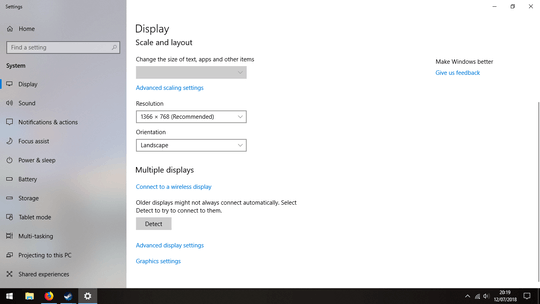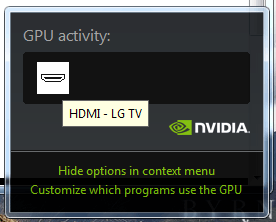4
1
My Laptop has two GPUs, an on-board HD3000 and an NVIDIA card. On Windows 7 they behaved all right. On the desktop the on-board HD3000 was usually used, but as soon as I launched a game the NVIDIA card took up the job. I know this because there is a little LED which changes its color depending on the graphic card currently used.
Now after updating to Windows 10 the GPU switch is going crazy. Sometimes they are switched several times within a minute, but most often the NVIDIA card is used, even when I am just browsing plain websites (e.g. currently while writing this). When I have the plain desktop on the screen and do nothing, the HD3000 is used after some seconds, but as soon as I move the mouse it switches again. This gets really annoying when watching youtube videos or streams via chrome. There can be minutes when the HD3000 is used constantly. But every now and then (sometimes several times in a minute) it changes to the NVIDIA card and back again after some seconds. The video stops for a second when it switches to the HD3000. Sound remains consistent.
Summing up I didn't recognize any real and understandable pattern behind this. I would expect Windows 10 to start using the NVIDIA card when the HD3000 approaches its performance limits, but I would have guessed that moving the mouse should not require that much power, not even on Windows 10.
Is there any way to get it working as before on Windows 7? If not, can I somehow disable or forbid Windows 10 to use the NVIDIA card for desktop applications? What would you do?
Here some more information about my system:
- Laptop Asus N53SV-SX711V
- Windows 10 Pro x64, Version 1511 Build 10586.420
- CPU: Intel Core i5-2410M @ 2.30GHz, integrated GPU: HD 3000
- GPU: GeForce GT 540M, Driver 368.39
- RAM: 8GB
Edit
I found out here, that the HD3000 is officially not supported by Intel. But "not supported" obviously doesn't mean it cannot be used, since in fact it's used sometimes. Also I can open the Intel Control Panel and change settings (driver version 9.17.10.4229).
Still: What can I do/try? What would you do except disabling the HD3000 completely?



What is the make and model laptop? – None – 2016-06-23T16:26:07.400
@SiXandSeven8ths It's an Asus N53SV-SX711V – Rob – 2016-06-23T19:49:30.000
1Which graphics card is used is selected by NVIDIA Optimus. That’s what you need to configure. – Daniel B – 2016-06-23T19:57:18.413
@DanielB Thanks for this keyword, just googled. Do you mean NVidia Control Panel --> 3D Settings --> Manage 3D Settings --> Global Settings Tab --> Preferred graphis processor? It's on Auto-select. Is it wrong? Trying "Integrated graphics" now. What is the difference between auto-selection and preferred:integrated? Why should auto-select work different from what I want and select the NVidia card if it is actually not necessary? – Rob – 2016-06-23T20:15:54.637
Unfortunately, I don’t have any Optimus-enabled devices, so you’ll have to figure out the rest yourself or wait for someone more knowledgeable. – Daniel B – 2016-06-23T20:44:01.040
After I changed the 3D settings to "Integrated graphics" I observed the behavior for a while now. Unfortunately nothing changed. – Rob – 2016-06-25T08:23:30.517
Try the latest 368.39 driver.
– harrymc – 2016-06-25T18:50:35.2971Also, I think your on-board video card (HD3000) is not supported on Windows 10. Try to disable it by booting into the BIOS, find the menu item that closely matches "Integrated Peripherals" or "On-Board Devices." The setting to disable the on-board graphics card may also be under the "Advanced" option. – harrymc – 2016-06-25T19:14:51.750
@harrymc Same problem with the latest driver 368.39. And disabling the integrated GPU completely is not an option. I would like to use it and sometimes Windows 10 is doing so. So it's not "not supported". – Rob – 2016-06-26T08:40:28.163
When you right-click on the desktop, do you have a "Graphics" item that goes into the Intel graphics control panel? Try also in Power options to set the plan to performance. – harrymc – 2016-06-26T15:41:22.303
I have a similar issue!! Windows 7 worked as expected. Windows 10 refuses to use the dedicated gpu at all most of the time. Updating drivers has been to no avail... Would really appreciate anybody's insight as well. – Blaine – 2016-06-27T03:11:39.420
@harrymc Yes, the graphics item is there which opens the intel graphics control panel. I set the power options to performance. Nothing changed. – Rob – 2016-06-27T06:56:37.367
Hi, this may be a long shot, but could you try this solution to your problem? It is a long shot but maybe this program will work. Just change the 'SHIM_RENDERING_MODE_ENABLE' to 'SHIM_RENDERING_MODE_DISABLE' https://eu.battle.net/d3/en/forum/topic/10746494566 This solution should force your GPU to work (or not work) on a specific program, something your Nvidia drivers fail to do
– Maarten – 2016-06-27T07:24:04.843In the intel graphics control panel, Options, choose Performance and set to on - Application Optimal Mode. In Power, Plugged in and in Battery, set Maximum Performance. Also in Plugged in, move the Display Power Saving Technology slider all the way to On, then Apply. In the Nvidia control panel, Manage 3D settings, ensure Preferred graphics processor is Nvidia. If preferred, you can also manage here Application specific settings. – harrymc – 2016-06-27T07:34:31.653
@MaartenOlijve There is no "SHIM_RENDERING_MODE_DISABLE" in the regarding drop down list. There is just "..._ENABLE", "..._INTEGRATED" (currently seleted), "..._AUTO_SELECT" and 6 other options. I guess INTEGRATED is what comes closest to DISABLE. – Rob – 2016-06-27T08:06:23.500
@harrymc There is no Display Power Saving Technology in Plugged in mode. I guess you mean the in Battery one. I applied your settings. Now it seems as if the integrated GPU is never used for anything. All your suggestions sounds as if they aim for disabling the integrated GPU somehow. But I actually still want to use it in order to save some energy. – Rob – 2016-06-27T08:23:33.707
1They were supposed to enhance the use of the GPU, but either they were for a very different version of Intel, or this is because of the general problem on your computer. Sorry, but without physical access to your computer, all I can suggest is to continue playing with the settings of Intel and Nvidia in the hope of arriving at a good balance. – harrymc – 2016-06-27T09:41:59.573
As Danial already mentioned, it is all about NVIDIA Optimus technology. Intel Control panel have no role in deciding which card to use. In fact, all the visual traffic goes through the main card and it is nVidia GPU that decide when to use the Integrated GPU. Intel probably don't know when it is active any way. So stick with nVidia control panel, try re-installing it. Removing the drivers and installing latest version. Unfortunately tho, as a long user of NVIDIA Optimus myself, I can guarantee you that you cant do much. Their technology is buggy as hell. Just search their forum. – Soroush Falahati – 2016-06-27T18:51:35.657
1And in your case, I think it is the Windows Usage of Visual Computing that makes NVIDIA Optimus to prefer the dedicated GPU. In other word, Windows is too heavy to be handles by integrated graphic all the time. – Soroush Falahati – 2016-06-27T18:53:04.773
@SoroushFalahati That's bad. I am guessing the same, but still it is hard to believe that the HD3000 is not powerful enough, since they advertised Windows 10 as very light and stuff. It can even run on ARM systems (Raspberry Pi) now... And what is still strange is that there doesn't seem to be a pattern behind it. Sometimes the dedicated switches on when I just move the mouse. And sometimes I can watch videos without the dedicated being used. It's just not understandable. – Rob – 2016-06-28T11:23:57.033
Windows 10 is not very light. All I can say is that since upgrading to it I experienced a distinct and general slow-down. The screens are nicer, but that takes graphical power that may be beyond the HD3000. – harrymc – 2016-06-28T12:56:19.140
@harrymc Ok, then I guess I just have to accept this. Maybe that's the reason why Intel didn't release a Windows 10 driver. Not because they are lazy or the HD3000 is too old, but because it just cannot do the job. – Rob – 2016-06-28T14:56:26.693